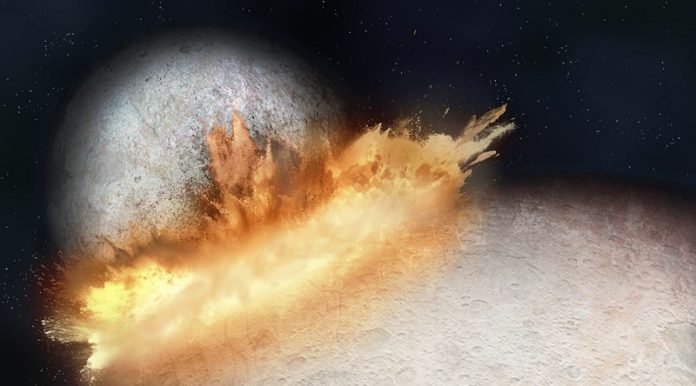
Pluto, once considered the ninth planet in our solar system, has intrigued scientists and the public alike with a distinct heart-shaped feature on its surface, spotted by NASA’s New Horizons mission in 2015.
This striking landmark, known as Tombaugh Regio, is partly made up of a region called Sputnik Planitia, which looks like a giant teardrop and covers a massive area—almost as big as a quarter of Europe or the United States.
Researchers from the University of Bern in Switzerland and the University of Arizona have used advanced computer simulations to dig deeper into how this unique geographical feature came to be.
They discovered that a colossal space collision with an object about the size of Arizona likely created Sputnik Planitia.
This event is thought to have happened very early in Pluto’s history, possibly shaping much of its current appearance.
The impact wasn’t a straightforward crash but more of a glancing blow, suggesting why Sputnik Planitia has its elongated shape and sits along the equator.
The object that hit Pluto was moving relatively slowly and at an angle, which allowed it to merge with Pluto without digging too deep or melting Pluto’s icy crust.
This finding is crucial because it challenges previous ideas about Pluto’s interior. Scientists once thought that beneath its icy surface, there might be a hidden ocean, much like those suspected on other distant celestial bodies.
However, this new study suggests that if Pluto ever had such an ocean, it might be much smaller than expected or possibly non-existent.
The heart-shaped region is interesting not just for its origins but also for its makeup. While much of Pluto’s surface is covered in methane ice, Sputnik Planitia is filled mainly with nitrogen ice. This area is about 2.5 miles lower in elevation than the surrounding landscape, which likely led to nitrogen ice accumulating there soon after the impact.
What makes Sputnik Planitia stay near Pluto’s equator rather than drifting towards the poles, as might be expected, also puzzles scientists.
The research proposes that when the object collided with Pluto, it left behind extra mass from its core at the impact site. This added weight could be keeping the depression near the equator.
The team’s findings, published in the journal Nature Astronomy, are not just about understanding Pluto better.
They also offer insights into other objects in the Kuiper Belt, a region of space beyond Neptune filled with icy bodies.
The study shows that even in the remote parts of our solar system, where things move slower and conditions are very different from those closer to the Sun, the details of such cosmic events are essential for understanding planetary formation and evolution.
This fresh perspective on Pluto’s unique heart-shaped feature, Sputnik Planitia, opens new doors for exploring the early history of other distant objects in our solar system. It also shows how powerful computer simulations have become in helping scientists unlock the mysteries of the universe.



